-
 Bitcoin
Bitcoin $81,840.6210
6.04% -
 Ethereum
Ethereum $1,597.9638
8.58% -
 Tether USDt
Tether USDt $0.9994
-0.03% -
 XRP
XRP $2.0026
9.84% -
 BNB
BNB $577.3606
3.57% -
 USDC
USDC $0.9999
-0.02% -
 Solana
Solana $114.7371
7.77% -
 Dogecoin
Dogecoin $0.1562
6.85% -
 TRON
TRON $0.2403
4.67% -
 Cardano
Cardano $0.6240
9.32% -
 UNUS SED LEO
UNUS SED LEO $9.3881
2.70% -
 Chainlink
Chainlink $12.3852
9.23% -
 Avalanche
Avalanche $18.0989
9.18% -
 Toncoin
Toncoin $2.9979
-1.98% -
 Stellar
Stellar $0.2349
5.96% -
 Hedera
Hedera $0.1711
12.93% -
 Shiba Inu
Shiba Inu $0.0...01206
10.22% -
 Sui
Sui $2.1408
8.96% -
 MANTRA
MANTRA $6.7043
7.73% -
 Bitcoin Cash
Bitcoin Cash $297.9565
9.10% -
 Litecoin
Litecoin $74.3475
4.91% -
 Polkadot
Polkadot $3.5400
2.22% -
 Dai
Dai $1.0000
0.00% -
 Bitget Token
Bitget Token $4.2732
4.64% -
 Ethena USDe
Ethena USDe $0.9989
0.02% -
 Hyperliquid
Hyperliquid $13.9883
12.96% -
 Pi
Pi $0.5955
5.14% -
 Monero
Monero $204.2372
4.47% -
 Uniswap
Uniswap $5.1811
7.08% -
 OKB
OKB $53.3943
3.95%
How to adjust leverage ratio in BingX futures trading
Adjusting leverage in BingX futures trading is key to managing risk and potential returns; choose wisely based on your strategy and market conditions.
Apr 03, 2025 at 04:07 pm
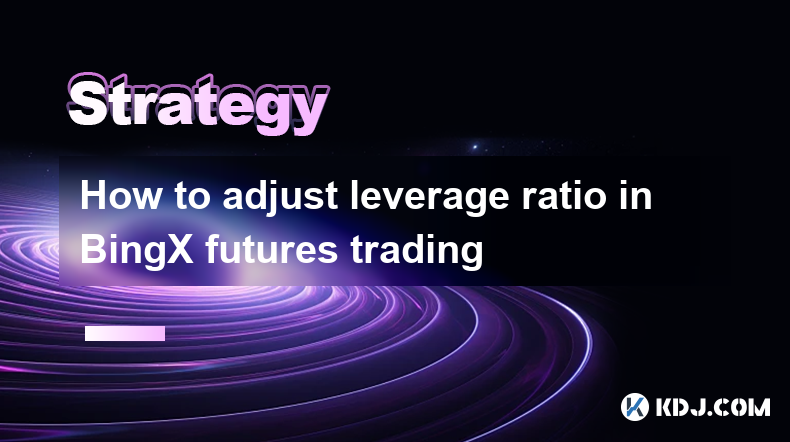
Adjusting the leverage ratio in BingX futures trading is a crucial aspect of managing your trading strategy effectively. Leverage allows traders to amplify their exposure to the market, potentially increasing both profits and losses. Understanding how to adjust leverage can help you tailor your trading approach to your risk tolerance and market outlook. In this article, we will explore the steps to adjust leverage in BingX futures trading, discuss the implications of different leverage levels, and provide tips for managing leverage effectively.
Understanding Leverage in BingX Futures Trading
Leverage in futures trading refers to the use of borrowed funds to increase the potential return on an investment. In BingX, leverage is expressed as a ratio, such as 1:10, which means that for every dollar of your own money, you can control up to ten dollars of the position. Higher leverage can lead to higher potential returns, but it also increases the risk of significant losses. It's essential to understand that while leverage can magnify gains, it can also magnify losses, making it a double-edged sword.
Steps to Adjust Leverage in BingX Futures Trading
Adjusting leverage in BingX is a straightforward process, but it requires careful consideration. Here are the steps to follow:
- Log into your BingX account and navigate to the futures trading section.
- Select the futures contract you wish to trade. BingX offers a variety of futures contracts, including those for cryptocurrencies like Bitcoin and Ethereum.
- Open the order form for the selected futures contract. You will see an option to adjust the leverage.
- Choose your desired leverage ratio from the available options. BingX typically offers leverage ranging from 1:1 to 1:125, depending on the contract.
- Confirm your selection and proceed with placing your order. The leverage you set will apply to the new position you are about to open.
Implications of Different Leverage Levels
The choice of leverage level can significantly impact your trading outcomes. Here are some implications of different leverage levels:
- Low Leverage (1:1 to 1:10): Using low leverage means you are trading with a smaller amount of borrowed funds. This approach is less risky and can be suitable for beginners or those with a conservative risk appetite. While potential profits may be lower, so are potential losses.
- Medium Leverage (1:10 to 1:50): Medium leverage strikes a balance between risk and reward. It can be suitable for traders who are comfortable with moderate risk and want to amplify their exposure to the market without taking on too much risk.
- High Leverage (1:50 to 1:125): High leverage can lead to significant profits if the market moves in your favor, but it also increases the risk of substantial losses. This level of leverage is best suited for experienced traders who can manage the associated risks effectively.
Tips for Managing Leverage Effectively
Managing leverage effectively is crucial for successful futures trading. Here are some tips to help you manage leverage:
- Understand Your Risk Tolerance: Before adjusting leverage, assess your risk tolerance. If you are risk-averse, consider using lower leverage. If you are comfortable with higher risk, you might opt for higher leverage.
- Use Stop-Loss Orders: Implementing stop-loss orders can help limit potential losses. By setting a stop-loss order, you can automatically close a position if the market moves against you, helping to manage the risk associated with high leverage.
- Monitor Your Positions Closely: High leverage requires close monitoring of your positions. Market volatility can lead to rapid changes in your account balance, so it's essential to stay vigilant and adjust your strategy as needed.
- Diversify Your Portfolio: Diversifying your trading portfolio can help spread risk. Instead of putting all your capital into a single high-leverage position, consider diversifying across different assets and leverage levels.
- Start with a Demo Account: If you are new to futures trading or adjusting leverage, consider starting with a demo account. This allows you to practice adjusting leverage and managing positions without risking real money.
Common Mistakes to Avoid When Adjusting Leverage
Adjusting leverage can be a powerful tool, but it's easy to make mistakes that can lead to significant losses. Here are some common mistakes to avoid:
- Overleveraging: One of the most common mistakes is using too much leverage. While high leverage can lead to high returns, it can also result in significant losses if the market moves against you.
- Ignoring Market Conditions: Failing to consider current market conditions when adjusting leverage can be risky. Volatile markets may require lower leverage to manage risk effectively.
- Not Using Risk Management Tools: Failing to use risk management tools like stop-loss orders can leave you vulnerable to large losses. Always use these tools to protect your capital.
- Chasing Losses: Trying to recover losses by increasing leverage can lead to a downward spiral. It's important to stick to your trading plan and not let emotions drive your decisions.
- Lack of Education: Not fully understanding how leverage works and its implications can lead to poor decision-making. Take the time to educate yourself about leverage and its risks before adjusting it.
The Role of Margin in Leverage Adjustment
Margin is closely related to leverage in futures trading. When you adjust leverage, you are essentially adjusting the amount of margin required to open and maintain a position. Here's how margin works in the context of leverage:
- Initial Margin: This is the amount of capital required to open a leveraged position. The higher the leverage, the lower the initial margin required.
- Maintenance Margin: This is the minimum amount of equity required to keep a position open. If your account balance falls below the maintenance margin, you may face a margin call, requiring you to deposit more funds or close the position.
- Margin Call: A margin call occurs when your account balance falls below the maintenance margin. To avoid a margin call, you can either deposit more funds or adjust your leverage to reduce the required margin.
Understanding the relationship between leverage and margin is crucial for managing your futures trading effectively. By adjusting leverage, you can control the amount of margin required, which in turn affects your risk exposure.
Practical Examples of Adjusting Leverage
To illustrate how adjusting leverage works in practice, let's consider a few examples:
- Example 1: Low Leverage Trading: Suppose you want to trade Bitcoin futures with a conservative approach. You decide to use a leverage ratio of 1:10. With a $1,000 investment, you can control a position worth $10,000. If Bitcoin's price increases by 1%, your profit would be $100 (1% of $10,000). However, if the price decreases by 1%, your loss would also be $100.
- Example 2: High Leverage Trading: Now, let's say you decide to use a leverage ratio of 1:100 for the same Bitcoin futures contract. With the same $1,000 investment, you can control a position worth $100,000. If Bitcoin's price increases by 1%, your profit would be $1,000 (1% of $100,000). However, if the price decreases by 1%, your loss would also be $1,000, which is your entire investment.
These examples highlight the potential rewards and risks associated with different leverage levels. It's essential to choose a leverage ratio that aligns with your risk tolerance and trading strategy.
Adjusting Leverage Based on Market Conditions
Market conditions play a significant role in determining the appropriate leverage level. Here are some considerations for adjusting leverage based on market conditions:
- Bullish Markets: In a bullish market, where prices are rising, you might consider using higher leverage to capitalize on potential gains. However, it's still important to manage risk carefully.
- Bearish Markets: In a bearish market, where prices are falling, using lower leverage can help protect your capital. High leverage in a bearish market can lead to significant losses.
- Volatile Markets: In highly volatile markets, it's often wise to use lower leverage to manage risk. Volatility can lead to rapid price swings, increasing the risk of margin calls and significant losses.
- Stable Markets: In stable markets, you might feel more comfortable using higher leverage, as the risk of sudden price movements is lower. However, always consider your overall risk tolerance and trading strategy.
The Psychological Aspect of Leverage Adjustment
Adjusting leverage is not just a technical decision; it also involves psychological factors. Here are some psychological aspects to consider:
- Emotional Control: High leverage can lead to heightened emotions, such as fear and greed. It's essential to maintain emotional control and stick to your trading plan, regardless of the leverage level.
- Overconfidence: Using high leverage can lead to overconfidence, especially after a series of successful trades. It's important to remain humble and recognize that past success does not guarantee future results.
- Fear of Missing Out (FOMO): FOMO can drive traders to use higher leverage to chase market movements. It's crucial to avoid making decisions based on FOMO and instead focus on your trading strategy and risk management.
- Loss Aversion: The fear of losses can lead traders to use lower leverage than necessary, potentially missing out on profitable opportunities. Balancing loss aversion with the potential for gains is key to effective leverage management.
Tools and Resources for Adjusting Leverage
BingX provides several tools and resources to help you adjust leverage effectively. Here are some of the key tools and resources available:
- Leverage Calculator: BingX offers a leverage calculator that helps you determine the potential profits and losses based on different leverage levels. This tool can be invaluable for planning your trades.
- Risk Management Tools: BingX provides various risk management tools, such as stop-loss orders and take-profit orders, to help you manage your positions effectively.
- Educational Resources: BingX offers educational resources, including articles, videos, and webinars, to help you understand leverage and its implications. Taking advantage of these resources can enhance your trading skills.
- Customer Support: If you have questions about adjusting leverage or any other aspect of futures trading, BingX's customer support team is available to assist you.
Common Questions About Adjusting Leverage in BingX Futures Trading
Q: What is the maximum leverage available in BingX futures trading?
A: The maximum leverage available in BingX futures trading can vary depending on the specific futures contract. Typically, BingX offers leverage up to 1:125 for certain contracts. It's important to check the specific leverage options available for the contract you are interested in trading.
Q: How does adjusting leverage affect my margin requirements?
A: Adjusting leverage directly impacts your margin requirements. Higher leverage means lower initial and maintenance margin requirements, allowing you to control larger positions with less capital. Conversely, lower leverage requires higher margin, reducing your exposure to the market.
Q: Can I change the leverage on an existing position?
A: In BingX, you cannot change the leverage on an existing position. To adjust leverage, you must close the existing position and open a new one with the desired leverage level. This process allows you to manage your risk exposure effectively.
Q: What are the risks of using high leverage in futures trading?
A: Using high leverage in futures trading can lead to significant profits if the market moves in your favor, but it also increases the risk of substantial losses. High leverage can result in rapid account depletion if the market moves against you, especially in volatile conditions. It's crucial to use risk management tools and monitor your positions closely when using high leverage.
Q: How can I determine the right leverage level for my trading strategy?
A: Determining the right leverage level depends on your risk tolerance, trading strategy, and market conditions. Start by assessing your risk tolerance and understanding the potential rewards and risks associated with different leverage levels. Use a leverage calculator to plan your trades and consider starting with a demo account to practice adjusting leverage without risking real money.
Disclaimer:info@kdj.com
The information provided is not trading advice. kdj.com does not assume any responsibility for any investments made based on the information provided in this article. Cryptocurrencies are highly volatile and it is highly recommended that you invest with caution after thorough research!
If you believe that the content used on this website infringes your copyright, please contact us immediately (info@kdj.com) and we will delete it promptly.
- IRS Targets DeFi Platforms with New Reporting Rules
- 2025-04-10 17:35:13
- Byte Federal Suffers a Major Data Breach Exposing Data of Up to 58,000 Customers
- 2025-04-10 17:35:13
- EV3 Invests in Dtravel to Expand the DePIN Ecosystem
- 2025-04-10 17:30:13
- Bitcoin (BTC) Market Shows Mild Rebound, BTC Price Fluctuating in a Narrow Range
- 2025-04-10 17:30:13
- Bitcoin (BTC) and Ether (ETH) Exchange-Traded Funds (ETFs) Saw Outflows Wednesday Despite Cryptocurrencies' Price Surges
- 2025-04-10 17:25:13
- Standard Chartered Makes an Epic XRP Price Prediction
- 2025-04-10 17:25:13
Related knowledge
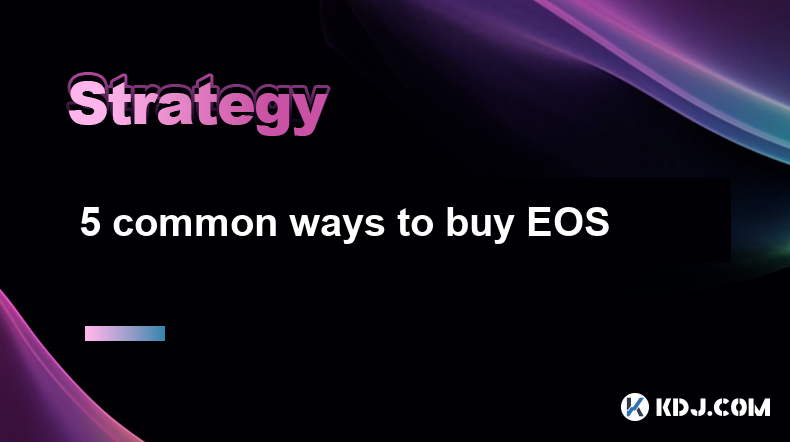
5 common ways to buy EOS
Apr 10,2025 at 01:14am
When it comes to purchasing EOS, one of the prominent cryptocurrencies in the blockchain ecosystem, there are several methods you can use. Each method has its own set of advantages and considerations. In this article, we will explore five common ways to buy EOS, providing a detailed guide on how to navigate each option effectively. Using Cryptocurrency ...
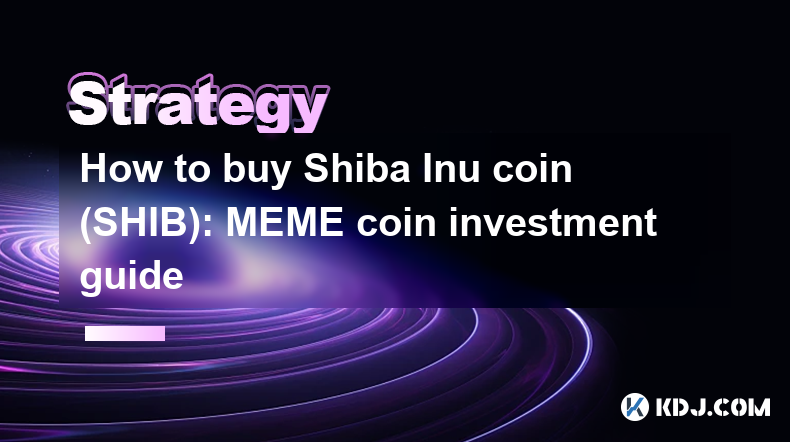
How to buy Shiba Inu coin (SHIB): MEME coin investment guide
Apr 10,2025 at 07:42am
Buying Shiba Inu coin (SHIB), a popular meme coin, can be an exciting venture into the world of cryptocurrency. This guide will walk you through the steps to purchase SHIB, provide insights into the coin's background, and offer tips on managing your investment. Whether you're a seasoned crypto investor or a newcomer, understanding how to buy and manage ...
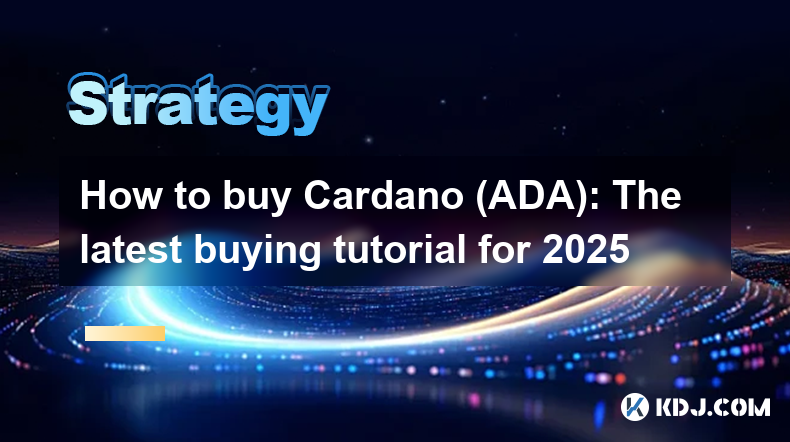
How to buy Cardano (ADA): The latest buying tutorial for 2025
Apr 09,2025 at 01:21am
Introduction to Cardano (ADA)Cardano (ADA) is a blockchain platform that aims to provide a more secure and scalable infrastructure for the development of decentralized applications and smart contracts. Created by Charles Hoskinson, one of the co-founders of Ethereum, Cardano differentiates itself through its rigorous academic approach and peer-reviewed ...
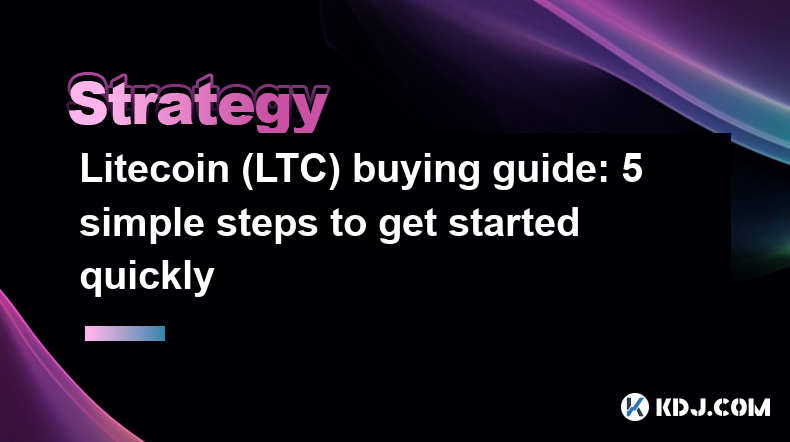
Litecoin (LTC) buying guide: 5 simple steps to get started quickly
Apr 09,2025 at 07:21pm
Litecoin (LTC) is a popular cryptocurrency that was created as a fork of Bitcoin. It offers faster transaction times and lower fees, making it an attractive option for many users. If you're interested in buying Litecoin, this guide will walk you through the process in five simple steps. Let's get started. Step 1: Choose a Reliable Cryptocurrency Exchang...
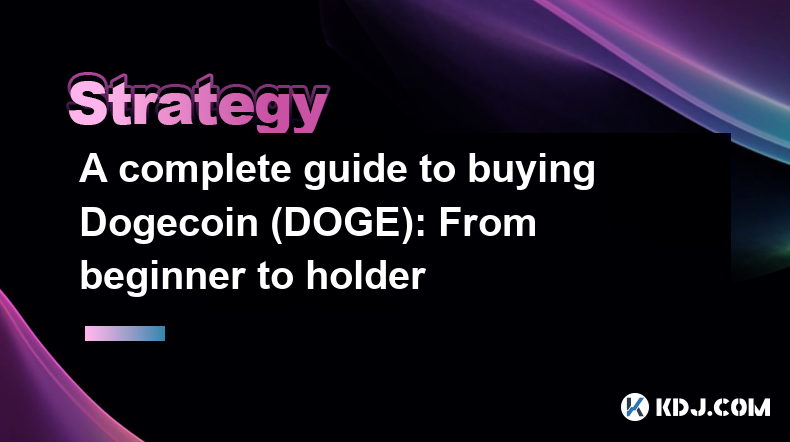
A complete guide to buying Bitcoincoin (Bitcoin): From beginner to holder
Apr 10,2025 at 12:56pm
Dogecoin (DOGE) started as a meme cryptocurrency but has grown to become one of the most popular digital assets in the market. If you're a beginner looking to invest in DOGE, this guide will walk you through the entire process, from understanding what Dogecoin is to becoming a holder. Let's dive in. What is Dogecoin?Dogecoin is a cryptocurrency ...
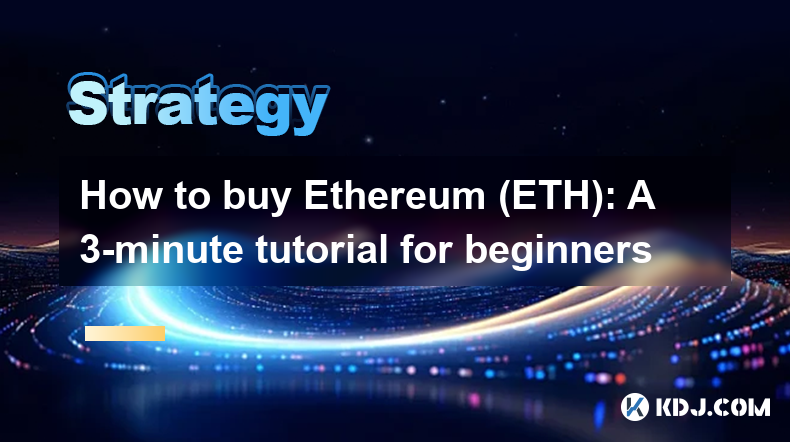
How to buy Ethereum (ETH): A 3-minute tutorial for beginners
Apr 10,2025 at 03:01am
Buying Ethereum (ETH) can be an exciting first step into the world of cryptocurrencies. This tutorial is designed to guide beginners through the process in just three minutes, ensuring you can start your crypto journey with confidence. Let's dive into the steps you need to follow to purchase Ethereum. Choosing a Cryptocurrency ExchangeThe first step in ...

5 common ways to buy EOS
Apr 10,2025 at 01:14am
When it comes to purchasing EOS, one of the prominent cryptocurrencies in the blockchain ecosystem, there are several methods you can use. Each method has its own set of advantages and considerations. In this article, we will explore five common ways to buy EOS, providing a detailed guide on how to navigate each option effectively. Using Cryptocurrency ...

How to buy Shiba Inu coin (SHIB): MEME coin investment guide
Apr 10,2025 at 07:42am
Buying Shiba Inu coin (SHIB), a popular meme coin, can be an exciting venture into the world of cryptocurrency. This guide will walk you through the steps to purchase SHIB, provide insights into the coin's background, and offer tips on managing your investment. Whether you're a seasoned crypto investor or a newcomer, understanding how to buy and manage ...

How to buy Cardano (ADA): The latest buying tutorial for 2025
Apr 09,2025 at 01:21am
Introduction to Cardano (ADA)Cardano (ADA) is a blockchain platform that aims to provide a more secure and scalable infrastructure for the development of decentralized applications and smart contracts. Created by Charles Hoskinson, one of the co-founders of Ethereum, Cardano differentiates itself through its rigorous academic approach and peer-reviewed ...

Litecoin (LTC) buying guide: 5 simple steps to get started quickly
Apr 09,2025 at 07:21pm
Litecoin (LTC) is a popular cryptocurrency that was created as a fork of Bitcoin. It offers faster transaction times and lower fees, making it an attractive option for many users. If you're interested in buying Litecoin, this guide will walk you through the process in five simple steps. Let's get started. Step 1: Choose a Reliable Cryptocurrency Exchang...

A complete guide to buying Bitcoincoin (Bitcoin): From beginner to holder
Apr 10,2025 at 12:56pm
Dogecoin (DOGE) started as a meme cryptocurrency but has grown to become one of the most popular digital assets in the market. If you're a beginner looking to invest in DOGE, this guide will walk you through the entire process, from understanding what Dogecoin is to becoming a holder. Let's dive in. What is Dogecoin?Dogecoin is a cryptocurrency ...

How to buy Ethereum (ETH): A 3-minute tutorial for beginners
Apr 10,2025 at 03:01am
Buying Ethereum (ETH) can be an exciting first step into the world of cryptocurrencies. This tutorial is designed to guide beginners through the process in just three minutes, ensuring you can start your crypto journey with confidence. Let's dive into the steps you need to follow to purchase Ethereum. Choosing a Cryptocurrency ExchangeThe first step in ...
See all articles





















































































